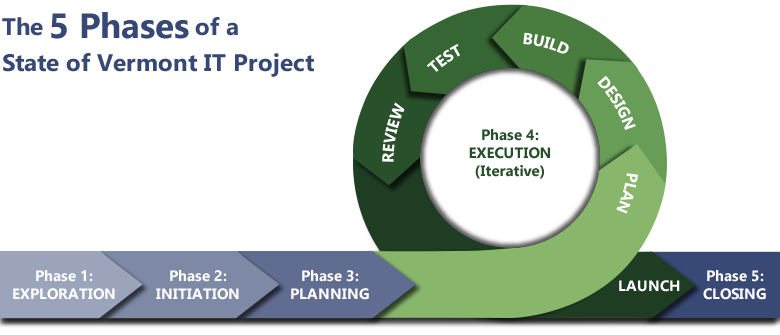We manage projects using a hybrid Waterfall-Agile process. By combining traditional Waterfall phases with an Agile Execution phase, we can capitalize on the clarity of Waterfall, while providing the flexibility and transparency of the Agile process, which is often needed to adapt to changing or unknown requirements.

 Phase 1: Exploration
Phase 1: Exploration
Exploration is about defining and justifying the business need, proposed solution, and estimated solution costs. The Business Lead works with the EPMO to obtain the State Chief Information Officer’s (CIO) approval on the Business Case/Cost Analysis (IT ABC Form). See the full Exploration Phase >
 Phase 2: Initiation
Phase 2: Initiation
During Initiation, the Business makes a commitment to move forward with the project and a Project Charter is created. The Project Charter provides the formal authorization to complete the project, commits the resources (funding and people), and defines initial business level requirements. Key project roles are also determined/assigned during this phase. See the full Initiation Phase >
 Phase 3: Planning
Phase 3: Planning
The phase moves further into defining detailed requirements, includes the procurement of the solution, and the project kick-off meeting. Project Managers plan for managing and/or tracking scope, schedule, budget, risks, issues, quality, resources, organizational change, and project documentation. See the full Planning Phase >
 Phase 4: Execution
Phase 4: Execution
The Execution Phase is completed using an agile approach, with iterative sprints of planning, designing, building, testing, reviewing, and launching of functional product increments. The Project Manager acts as a scrum master to ensure the team has what they need to complete the work of the project and ensure Stakeholders stay updated with project status reports. See the full Execution Phase >
 Phase 5: Closing
Phase 5: Closing
The heavy lifting is done and it is time to wrap up the project by gaining formal User Acceptance (that the project work is complete based on the requirements); completing a Lessons Learned and Customer Survey; holding a Close-out meeting and completing a Close-out report; finalizing and archiving project documentation; and transitioning to Operations. See the full Closing Phase >
